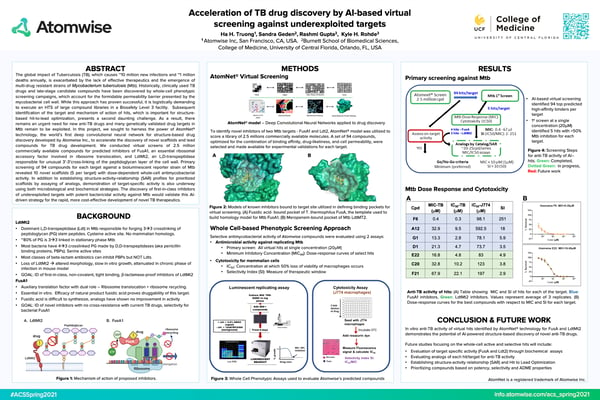Acceleration of TB Drug Discovery by AI-Based Virtual Screening Against Underexploited Targets
At the American Chemical Society Spring 2021 Virtual Meeting & Expo, several Atomwise members and partners were selected to present their research and work. Learn what our Atoms have been working on below and visit Atomwise at ACS Spring 2021 Virtual Meeting & Expo for other presentation sessions.
 Ha Truong, PhD
Ha Truong, PhD
Atomwise
Co-Presenter: Kyle H. Rohde, PhD
Co-Authors: Sandra Geden, Rashmi Gupta, Kyle H. Rohde (University of Central Florida)
Title: Acceleration of TB Drug Discovery by AI-Based Virtual Screening Against Underexploited Targets
Division: MEDI
Abstract
The global impact of Tuberculosis (TB), which causes ~10 million new infections and ~1 million deaths annually, is exacerbated by the lack of effective therapeutics and the emergence of multi-drug resistant strains of Mycobacterium tuberculosis (Mtb). Historically, clinically used TB drugs and late-stage candidate compounds have been discovered by whole-cell phenotypic screening campaigns, which account for the formidable permeability barrier presented by the mycobacterial cell wall. While this approach has proven successful, it is logistically demanding to execute an HTS of large compound libraries in a Biosafety Level 3 facility. Subsequent identification of the target and mechanism of action of hits, which is important for structure-based hit-to-lead optimization, presents a second daunting challenge. As a result, there remains an urgent need for new anti-TB drugs and many genetically validated drug targets in Mtb remain to be exploited. In this project, we sought to harness the power of AtomNet® technology, the world’s first deep convolutional neural network for structure-based drug discovery developed by Atomwise, to accelerate the discovery of novel scaffolds and lead compounds for TB drug development. We conducted virtual screens of 2.5 million commercially available compounds for predicted inhibitors of FusA1, an essential ribosomal accessory factor involved in ribosome translocation, and LdtMt2, an L,D-transpeptidase responsible for unusual 3’-3’cross-linking of the peptidoglycan layer of the cell wall. Primary screening of 94 compounds for each target against a bioluminescent reporter strain of Mtb revealed 10 novel scaffolds (5 per target) with dose-dependent whole-cell antimycobacterial activity. In addition to establishing structure-activity-relationship (SAR) profiles for prioritized scaffolds by assaying of analogs, demonstration of target-specific activity is also underway using both microbiological and biochemical strategies. The discovery of first-in-class inhibitors of underexploited targets with potent bactericidal activity against Mtb would validate this AI-driven strategy for the rapid, more cost-effective development of novel TB therapeutics.
Poster Presentation
Join our team
Our team is comprised of over 80 PhD scientists who contribute to a high-performance academic-like culture that fosters robust scientific and technical excellence. We strongly believe that data wins over opinions, and aim for as little dogma as possible in our decision making. Learn more about our team and opportunities at Atomwise.
Related Posts
Subscribe
Stay up to date on new blog posts.
Atomwise needs the contact information you provide to send you updates. You may unsubscribe from these communications at any time. For information please review our Privacy Policy.

